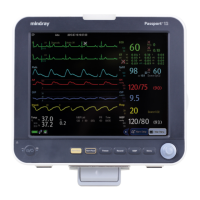Passport 12/Passport 8 Operator’s Manual 17-3
17.3 MAC Values
Minimum alveolar concentration (MAC) is the minimum concentration of the agent in the alveoli. It is a basic index to
indicate the depth of anesthesia. The standard ISO 21647 defines MAC as this: alveolar concentration of an inhaled
anesthetic agent that, in the absence of other anesthetic agents and at equilibrium, prevents 50% of patients from
moving in response to a standard surgical stimulus.
Minimum alveolar concentration (MAC) values are listed below:
Agent Des Iso Enf Sev Hal N2O
1 MAC 6%* 1.15% 1.7% 2.1% 0.77% 105%**
* The data is taken from a 25-year-old patient.
** indicates 1 MAC nitrous oxide can only be reached in hyperbaric chamber.
NOTE
The MAC values shown in the table above are those published by the U.S. Food and Drug Administration for
a healthy 40-year-old adult male patient.
In actual applications, the MAC value may be affected by age, weight and other factors.
The formula to calculate the MAC value is as follows:
−
=
=
1
0
N
i
age
i
iAgentVol
EtAgent
MAC
Where N is the number of all agents (including N
2
O) that the AG module can measure, EtAgenti is the concentration of
each agent, and AgentVol
age
i is the concentration of each agent at 1 MAC with age correction.
The formula for calculating age correction of 1 MAC is:
))40(00269.0(
40
10
−×−
×=
age
age
MACMAC
For example, the Des concentration at 1 MAC of a 60-year old patient is
88.0%610%6
))4060(00269.0(
×=×
−×−
.
The AG module measures there are 4% of Des, 0.5% of Hal and 50% of N
2
O in the patient’s end-tidal gas:
04.2
88.0%105
%50
%77.0
%5.0
88.0%6
%0.4
=
×
+
×
+
×
=
0.88
MAC
NOTE
The formula above is only suitable for patients who are older than one year. If the patient is less than one
year, the system uses one year to do age correction.

